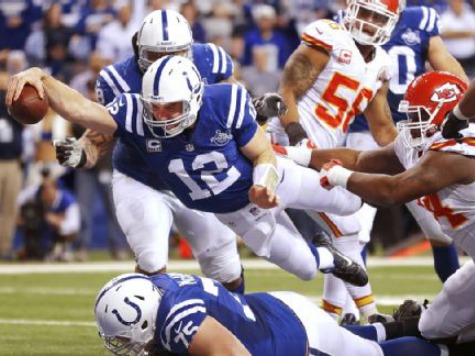Media critic Neal Gabler calls the NFL a league for white males. Did he intend to hit the “H” on his keyboard instead of that “F” two buttons away?
“It isn’t a coincidence that the rise of the National Football League mirrored the rise of American conservatism,” Gabler believes. “In almost every way, the NFL was the league of the well-off, conservative white male.”
Leaving aside the rather obvious fact that African Americans constitute more than two thirds of the league’s players, the NFL’s history clashes with Gabler’s imagination. A Native American, Jim Thorpe, served as the league’s first commissioner. It integrated from the outset. An African American coach led his team to the league championship in the NFL’s second year. Though owners upheld a de facto segregation during the Depression and world war that followed, when the Rams reintegrated upon moving to Los Angeles the league quickly followed. Bigots never show themselves as losers more than on the playing field.
And playing fields operate as the real melting pot. It’s difficult to maintain feelings of racial superiority when competing. Harder still is to hold an ethnic grudge when forced to cooperate with teammates of diverse backgrounds. Football, like all sports, breeds respect, not racism. Before Brown v. Board of Education desegregated schools, kids around the country had integrated the diamond, gridiron, and hardwood. Blacks and whites and Hispanics and Asians may not live in the same neighborhoods, watch the same television shows, or attend the same churches. They play on the same teams.
And they cheer for them together, too. Football unites Americans in a way that nothing else does. We may disagree on the president and what cable news network we watch. We come together on football. Whether under the lights on Friday night, in a sleepy college town turned booming metropolis on a Saturday afternoon, or on Super Bowl Sunday when 120 million Americans all watch the same television program, football brings Americans together in a way that few forces outside of wars and tragedies do. Play spectator to America’s favorite spectator sport and you’ll see a sea of faces of every hue and age in the stands.
“Why does the NFL have such a tenacious hold on the national consciousness–particularly that of white males, the primary fans of professional sports?” Gabler asks. “It might be that the NFL, in both its high points and its low ones, encapsulates the prevailing white male conservative ethos of modern America better than any other league. The triumph of the NFL is a tribute to the triumph of American conservatism.”
Even on this Gabler misunderstands the game. Baseball is a game of tradition. Football is an evolutionary sport of change. My book The War on Football: Saving America’s Game details that although progressives have often railed against football–from Charles Eliot in 1905 to Neal Gabler today–the sport plays as the ultimate progressive’s sport in which planning sublimates the individual into a cog of the larger machine ordered by a managerial class of coaches. The forward pass, the shape of the ball, two-platoon football, the number of men required on the line of scrimmage, and so much else has changed since Rutgers beat Princeton in the first intercollegiate game 145 years ago. The sport constantly evolves. Think about its name. Football once implied kicking. Even the nickname “gridiron”serves as an anachronism. It refers to the lateral and longitudinal lines that once appeared on a football field. We now see markers every five yards moving sideways on a field but no more lines the long way. The Giants, Pirates, and Reds still play baseball the way the Giants, Pirates, and Reds played baseball in the nineteenth century. The 49ers, Steelers, and Bengals play football in a manner completely unrecognizable to those students playing in that 25-to-a-side game in 1869 in which combatants sought to kick a round ball beneath a goalpost to score points.
Sports don’t lend themselves to red state/blue state compartmentalization. Football transcends politics the way it transcends race and religion and so many other categories. Gabler may be liberal and he may dislike football. But that doesn’t mean that people who vote as he does on a Tuesday in November tune out as he does on Sundays in November. Imagining that they do embraces a narcissistic fallacy and reveals an aesthetic immaturity. Politics isn’t so all-consuming as to dictate one’s musical, architectural, or sporting preferences. Political animals may see ideology or race in everything. That doesn’t mean that others do–or that it’s even there.
Woodrow Wilson (Wesleyan coach), Dwight Eisenhower (West Point linebacker), Theodore Roosevelt (a pigskin savior), Herbert Hoover (Stanford team manager), George W. Bush (Yale cheerleader), Gerald Ford (Michigan national champion), Ronald Reagan (the Gipper), and John F. Kennedy (touch-football popularizer) may have endorsed conflicting policies. They agreed on the gridiron.
Football isn’t red state or blue state. It isn’t white or black. It’s red, white, and blue.

COMMENTS
Please let us know if you're having issues with commenting.